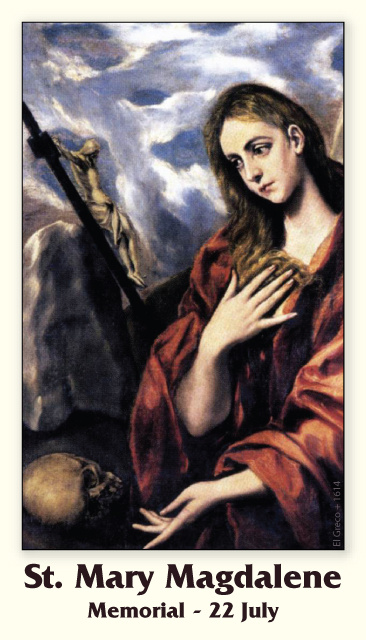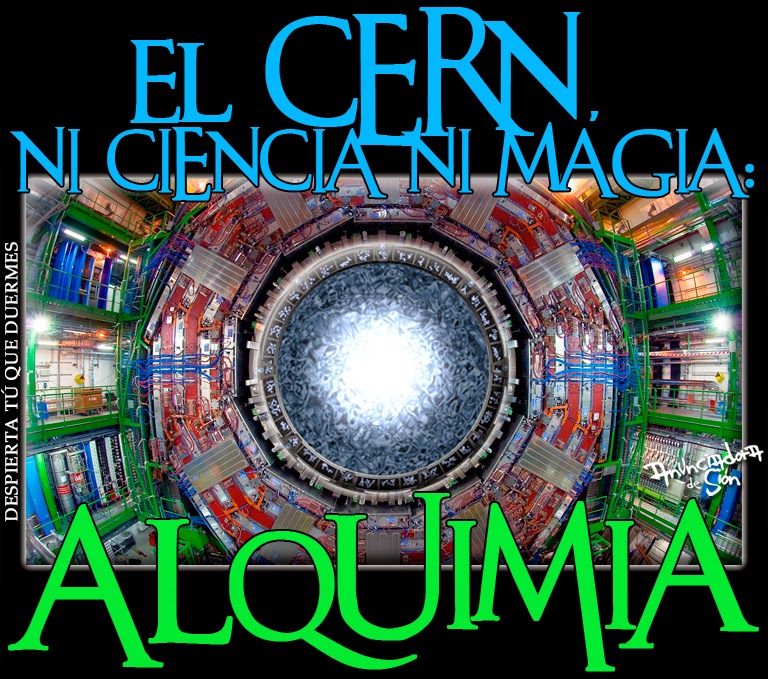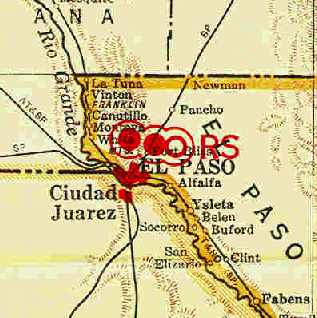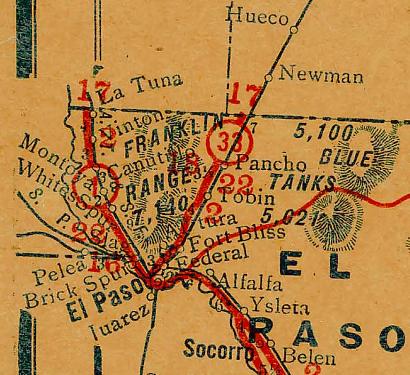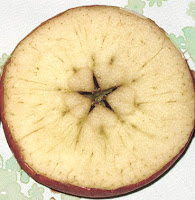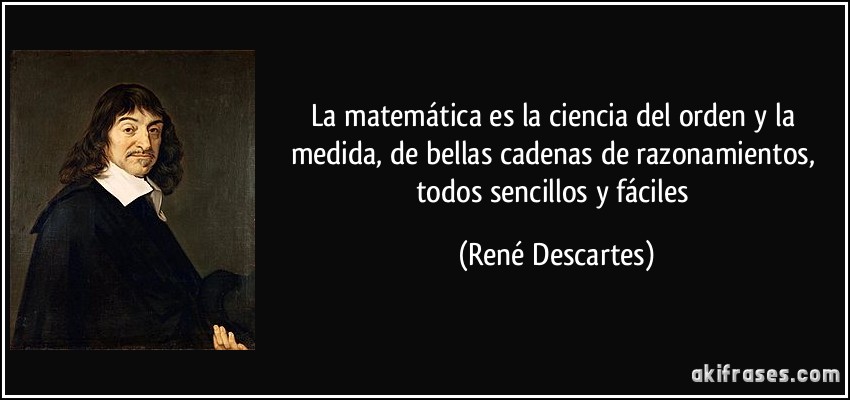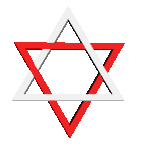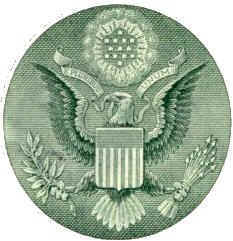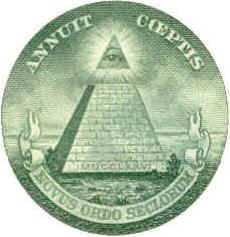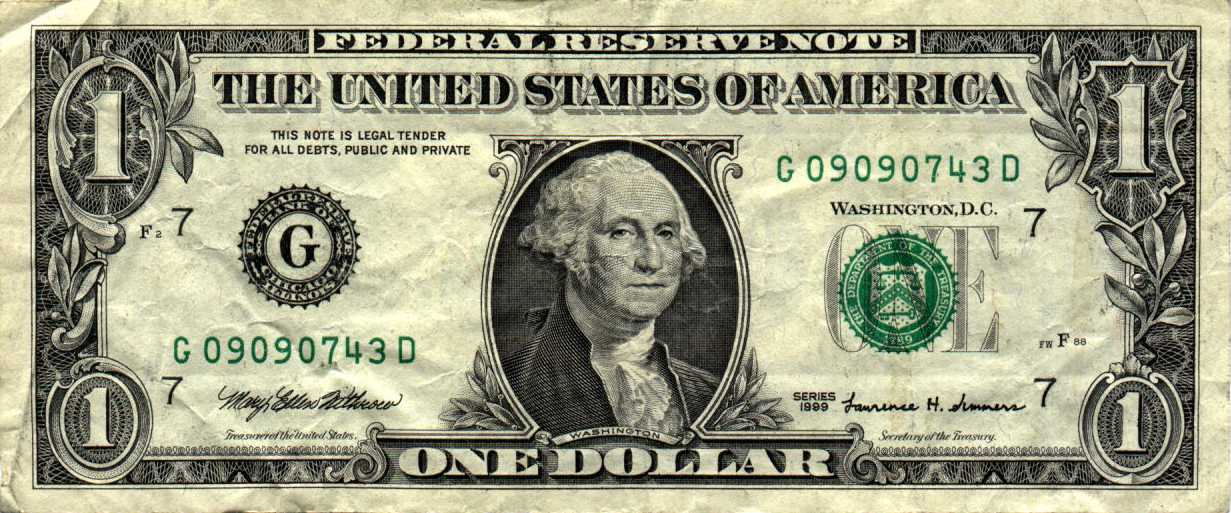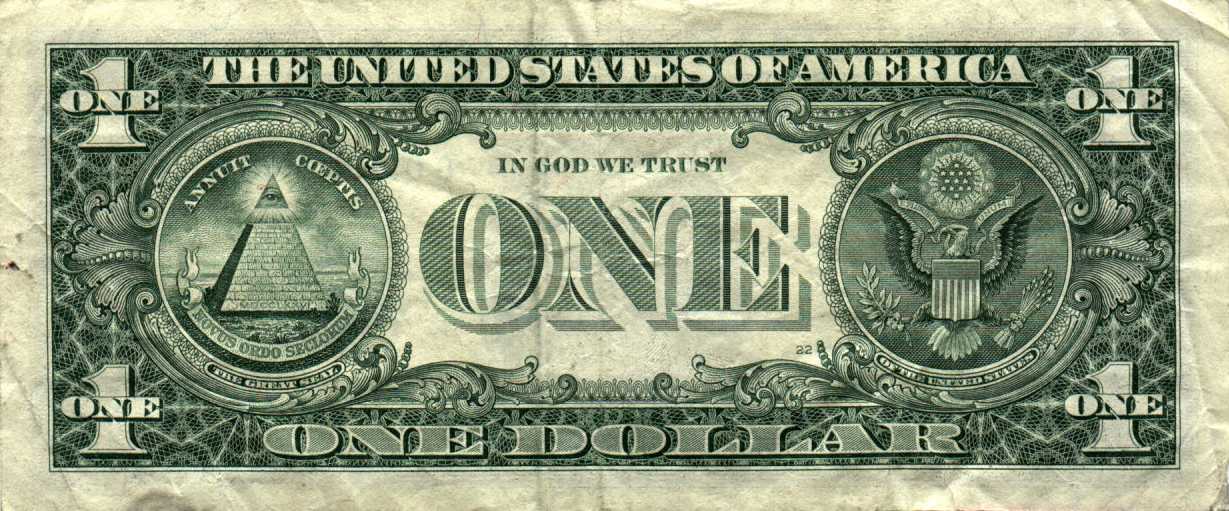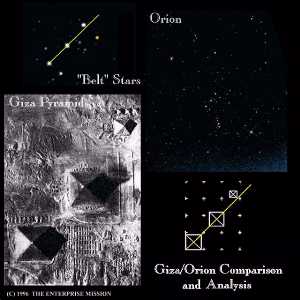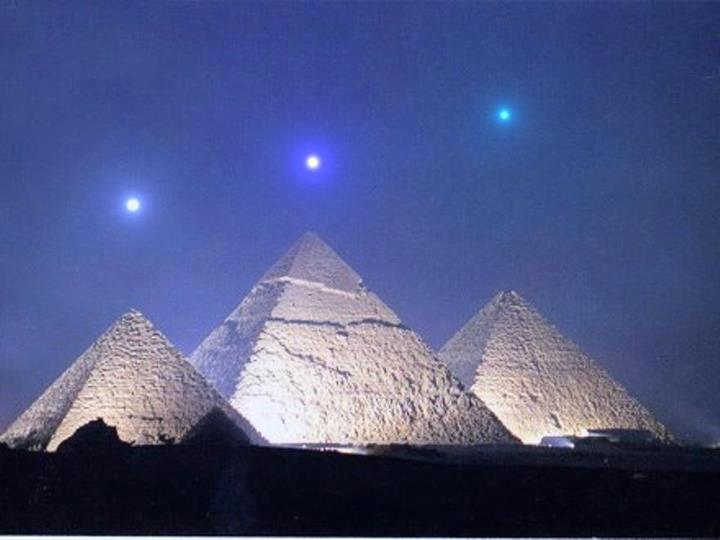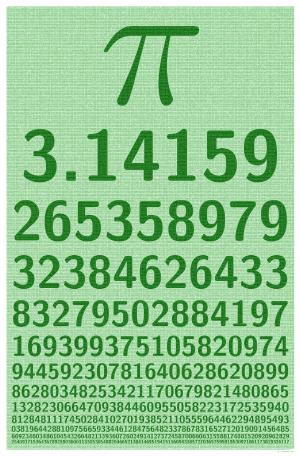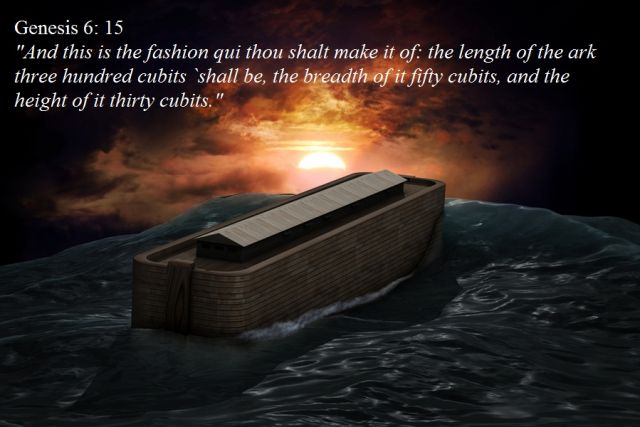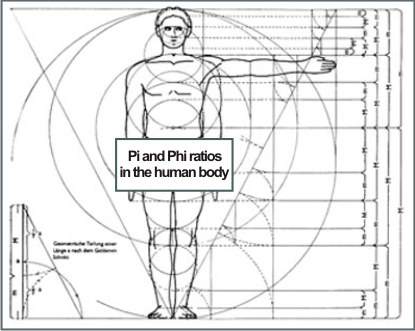|
|
General: LA RAZON EN LA BIBLIA TAMBIEN ES UNA FORMA DE LLEGAR A LA VERDAD
Escolher outro painel de mensagens |
|
|
|
|

ROMANOS 1
21. Pues habiendo conocido a Dios, no le glorificaron como a Dios, ni le dieron gracias, sino que se envanecieron en sus razonamientos, y su necio corazón fue entenebrecido.
22. Profesando ser sabios, se hicieron necios,
23. y cambiaron la gloria del Dios incorruptible en semejanza de imagen de hombre corruptible, de aves, de cuadrúpedos y de reptiles.
24. Por lo cual también Dios los entregó a la inmundicia, en las concupiscencias de sus corazones, de modo que deshonraron entre sí sus propios cuerpos,
25. ya que cambiaron la verdad de Dios por la mentira, honrando y dando culto a las criaturas antes que al Creador, el cual es bendito por los siglos. Amén.
26. Por esto Dios los entregó a pasiones vergonzosas; pues aun sus mujeres cambiaron el uso natural por el que es contra naturaleza,
27. y de igual modo también los hombres, dejando el uso natural de la mujer, se encendieron en su lascivia unos con otros, cometiendo hechos vergonzosos hombres con hombres, y recibiendo en sí mismos la retribución debida a su extravío.
28. Y como ellos no aprobaron tener en cuenta a Dios, Dios los entregó a una mente reprobada, para hacer cosas que no convienen;
29. estando atestados de toda injusticia, fornicación, perversidad, avaricia, maldad; llenos de envidia, homicidios, contiendas, engaños y malignidades;
30. murmuradores, detractores, aborrecedores de Dios, injuriosos, soberbios, altivos, inventores de males, desobedientes a los padres,
31. necios, desleales, sin afecto natural, implacables, sin misericordia;
32. quienes habiendo entendido el juicio de Dios, que los que practican tales cosas son dignos de muerte, no sólo las hacen, sino que también se complacen con los que las practican.
|
|
|
|
|
|
|
|
http://lucesquenobrillan.blogspot.com.ar/2014/01/la-probable-pronunciacion-del-nombre.html
La probable pronunciación del nombre que representa el tetragrámaton griego YHWH
Hoy día se conocen dos pronunciaciones del tetragrámaton o cuatro letras del hipotético nombre de Dios que en griego se escribe con las vocales YHWH (Ipsilon, Eta, Omega, Eta, son vocales, no consonantes), que en el alfabeto griego se pronuncian IEUE, respectivamente, o también IEOE, ya que la letra W (Omega, no uve doble) admite las dos pronunciaciones (U y O). Por lo general en las biblias de las iglesias protestantes el tetragramaton se transcribe como Jehovah. En las católicas, como Yahweh, forma ésta que, según los eruditos en la materia, sería la pronunciación más correcta del tetragramaton con que se representa el nombre divino. Otros eruditos defienden la forma Yahwah.
La pronunciación Jehovah se origina al haber intercalado la Iglesia Católica al tetragrámaton las vocales de la palabra Adonaí (Señor), supliendo la primera A por una E. Indistintamente se pronunciaba el nombre divino como Jehovah o Jehovih. La escritura y pronunciación Jehovah fue la más usada en las biblias católicas. Cuando los protestantes se separaron, adoptaron la forma Jehovah que aparece en sus biblias hasta este día. Posteriormente la Iglesia Católica, para diferenciar la pronunciación, adoptó la forma Yaweh que algunos estudiosos entendían como más correcta, pero que a día de hoy no se sabe si realmente lo es, y lo más probable es que no lo sea.
El historiador Diodoro de Sicilia, del siglo I antes de nuestra era, escribe que la pronunciación del tetragrámaton era IAO. La transcripción YHWH en griego habría conservado la pronunciación original hebrea. Según ello, una de dos, o las letras H no tendrían otra función que la de alargar el sonido vocal de las caracteres precedentes, a saber, Y, que se pronunciaría IAA, y W, con pronunciación de O alargada. La pronunciación sonaría, pues, como IAAOO; o bien ambas H eran mudas y el nombre sonaría como IAO ó YAHOH. No ha de olvidarse que el nombre divino abreviado aparece en la Biblia como YAH ó JAH.
Cada vez más eruditos están convencidos de que IAO ó YAHOH era la pronunciación correcta del tetragrámaton escrito YHWH en griego. Siglos atrás así lo habían creído estudiosos como Orígenes, Ireneo y Clemente de Alejandría, aunque este último defendía la expresión IAOU, dándole el sonido OU a la W. Tal pronunciación del hipotético nombre de Dios que esconde el tetragrámaton YHWH estaría de acuerdo con los arcaicos símbolos o caracteres representados como IO, donde la I se pronunciaba IA.
El símbolo I representaba en la antigüedad el concepto masculino, en tanto que O aludía al femenino. Ambos juntos forman IO, significando que la persona a quien se atribuyen los dos símbolos reúne en sí mismo los principios masculino y femenino, siendo el creador de cuanto existe, material o energéticamente. En griego los símbolos IO se funden en una sola letra, la que se denomina PHI, pronunciada F, que encaja el distintivo I en O. PHI es asimismo la designación del número áureo, de valor 1,618, empleado sobre todo en el arte arquitectónico maestro, algo que no está al alcance de todos los arquitectos. Por tanto PHI designa sapiencia profunda. No habría, pues, otra denominación más acorde para la sapiencia del Ser Creador que la representación IO, los principios masculino y femenino, ocultos en el tetragrámaton YHWH y pronunciado YAHOH ó IAO.
|
|
|
|
|
TEOTIHUACAN-GIZE-NUMERO DE ORO PHI=1.618-RELACION CON LA INDEPENDENCIA DEL ESTADO DE ISRAEL
ISRAEL
ISIS
RA
ELOHIM
330 AÑOS EXACTOS MAS 1618=1948 (INDEPENDENCIA DE ISRAEL)






¿Qué es phi?
Phi y la serie de Fibonacci
Funciones trigonométricas
Razones matemáticas
Pentágono
Espirales Áureas
Inicio :: Ver temas relacionados: Decalogo Geometria Sagrada :: Número de Oro :: Merkaba
¿Qué es phi?
Phi (1.618033988749895... ), pronunciado como fi, es un numero irracional como Pi ( 3.14159265358979... ), pero con muchas características matemáticas inusuales. Phi es la base de la Proporción Dorada. La razón o proporción determinada por Phi (1.618...) era conocida por los Griegos como la “Sección Dorada” y por los artistas del renacimiento como la “Proporción Divina”. También se le conoce como la razón Dorada o la Proporción Áurea.
Phi, como Pi, es una razón definida por una construcción geométrica.
Pi es la relación de la circunferencia de un círculo respecto a su diámetro. Phi es la proporción de los segmentos de una línea que resultan cuando una línea es dividida de una forma única y especial.
La línea es dividida para que la proporción de la longitud de la línea entera (A) respecto a la longitud del segmento de la línea mayor (B) sea igual que la proporción de la longitud del segmento de la línea mayor (B) a la longitud del segmento de la línea menor (C)

Esto es que A es 1.618... veces B, y B es 1.618… veces C. Recíprocamente, C es 0.618... de B y B es 0.618... de A. Phi con mayúscula "Phi" es 1.6180339887..., mientras que phi con minúscula es 0.6180339887, el reciproco de Phi o Phi menos 1.
Lo que hace a phi incluso mas inusual es que puede derivarse de muchas formas y ser encontrado en proporcionalmente en el universo. Phi F puede ser derivado por: la serie numérica descubierta por Leonardo Fibonacci, matemáticas y geometría.
Phi y la serie de Fibonacci
Leonardo Fibonacci, por herencia del mundo árabe, descubrió la serie que nos lleva a phi. En el siglo XII, Leonardo Fibonacci descubrió una serie numérica simple que es la base de la increíble relación que encontramos detrás de phi. Empezando con 0 y 1, cada número de la serie es simplemente la suma de los dos anteriores. Así: 0, 1, 1, 2, 3, 5, 8, 13, 21, 34, 55, 89, 144, . . .
La razón (proporción) de cada par sucesivo de números en la serie se aproxima a phi (1.618. . .). Así si dividimos 5 entre 3 es 1.666..., y 8 entre 5 es 1.60. En la medida en la que vamos mas lejos del 0 (punto de inicio de la secuencia) nos acercamos al valor de phi.
La tabla de abajo nos muestra como las proporciones de números sucesivos en la serie Fibonacci se aproxima a Phi.
Puedes computar cualquier número de la serie Fibonacci fácilmente. Usa phi para saber cualquier numero (n) de la serie Fibonacci (f)
fn = Fn / 5½
Phi puede derivarse matemáticamente resolviendo la ecuación:
n2 - n1 - n0 = 0 que es lo mismo que n2 - n - 1 = 0
Esta ecuación la rescribimos y nos queda así:
n2 = n + 1 y 1 / n = n - 1
La solución a la ecuación es la raíz cuadrada de 5 más 1 dividido entre 2
( 5½ + 1 ) / 2 = 1.6180339... = F
Esto resulta en dos propiedades únicas de phi:
Si elevas al cuadrado a phi, obtienes un numero exactamente 1 mayor que phi: 2.6180...
F2 = F + 1
Si divides a phi entre 1, obtienes un numero exactamente a 1 menos phi: 0.6180...:
1 / F = F - 1
Phi, curiosamente, puede ser expresado en cinco: 5 ^ .5 * .5 + .5 = F
Puedes usar phi para computar un número n en la serie Fibonacci (fn): fn = Fn / 5½
Como por ejemplo, el número 40 de la serie Fibonacci es 102, 334, 155, que puede expresarse
f40 = F40 / 5½ = 102,334,155
Este método en realidad nos provee un estimado que siempre esta cerca del numero correcto Fibonacci.
http://www.iuca.net/gs/que%20es%20phi.htm
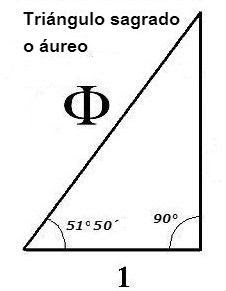
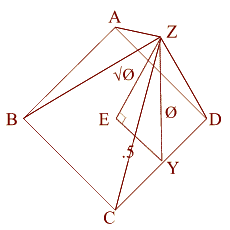









¿Qué es phi?
Phi y la serie de Fibonacci
Funciones trigonométricas
Razones matemáticas
Pentágono
Espirales Áureas
Inicio :: Ver temas relacionados: Decalogo Geometria Sagrada :: Número de Oro :: Merkaba
¿Qué es phi?
Phi (1.618033988749895... ), pronunciado como fi, es un numero irracional como Pi ( 3.14159265358979... ), pero con muchas características matemáticas inusuales. Phi es la base de la Proporción Dorada. La razón o proporción determinada por Phi (1.618...) era conocida por los Griegos como la “Sección Dorada” y por los artistas del renacimiento como la “Proporción Divina”. También se le conoce como la razón Dorada o la Proporción Áurea.
Phi, como Pi, es una razón definida por una construcción geométrica.
Pi es la relación de la circunferencia de un círculo respecto a su diámetro. Phi es la proporción de los segmentos de una línea que resultan cuando una línea es dividida de una forma única y especial.
La línea es dividida para que la proporción de la longitud de la línea entera (A) respecto a la longitud del segmento de la línea mayor (B) sea igual que la proporción de la longitud del segmento de la línea mayor (B) a la longitud del segmento de la línea menor (C)

Esto es que A es 1.618... veces B, y B es 1.618… veces C. Recíprocamente, C es 0.618... de B y B es 0.618... de A. Phi con mayúscula "Phi" es 1.6180339887..., mientras que phi con minúscula es 0.6180339887, el reciproco de Phi o Phi menos 1.
Lo que hace a phi incluso mas inusual es que puede derivarse de muchas formas y ser encontrado en proporcionalmente en el universo. Phi F puede ser derivado por: la serie numérica descubierta por Leonardo Fibonacci, matemáticas y geometría.
Phi y la serie de Fibonacci
Leonardo Fibonacci, por herencia del mundo árabe, descubrió la serie que nos lleva a phi. En el siglo XII, Leonardo Fibonacci descubrió una serie numérica simple que es la base de la increíble relación que encontramos detrás de phi. Empezando con 0 y 1, cada número de la serie es simplemente la suma de los dos anteriores. Así: 0, 1, 1, 2, 3, 5, 8, 13, 21, 34, 55, 89, 144, . . .
La razón (proporción) de cada par sucesivo de números en la serie se aproxima a phi (1.618. . .). Así si dividimos 5 entre 3 es 1.666..., y 8 entre 5 es 1.60. En la medida en la que vamos mas lejos del 0 (punto de inicio de la secuencia) nos acercamos al valor de phi.
La tabla de abajo nos muestra como las proporciones de números sucesivos en la serie Fibonacci se aproxima a Phi.
Puedes computar cualquier número de la serie Fibonacci fácilmente. Usa phi para saber cualquier numero (n) de la serie Fibonacci (f)
fn = Fn / 5½
Phi puede derivarse matemáticamente resolviendo la ecuación:
n2 - n1 - n0 = 0 que es lo mismo que n2 - n - 1 = 0
Esta ecuación la rescribimos y nos queda así:
n2 = n + 1 y 1 / n = n - 1
La solución a la ecuación es la raíz cuadrada de 5 más 1 dividido entre 2
( 5½ + 1 ) / 2 = 1.6180339... = F
Esto resulta en dos propiedades únicas de phi:
Si elevas al cuadrado a phi, obtienes un numero exactamente 1 mayor que phi: 2.6180...
F2 = F + 1
Si divides a phi entre 1, obtienes un numero exactamente a 1 menos phi: 0.6180...:
1 / F = F - 1
Phi, curiosamente, puede ser expresado en cinco: 5 ^ .5 * .5 + .5 = F
Puedes usar phi para computar un número n en la serie Fibonacci (fn): fn = Fn / 5½
Como por ejemplo, el número 40 de la serie Fibonacci es 102, 334, 155, que puede expresarse
f40 = F40 / 5½ = 102,334,155
Este método en realidad nos provee un estimado que siempre esta cerca del numero correcto Fibonacci.
http://www.iuca.net/gs/que%20es%20phi.htm





|
|
|
|
|
| Reply |
Message 21 of 28 on the subject |
|
|
|
|
| Reply |
Message 22 of 28 on the subject |
|
|
|
| Reply |
Message 539 of 550 on the subject |
|
|
|
|
|
| Reply |
Message 224 of 224 on the subject |
|
TUESDAY, MAY 18, 2010
BORROMEAN RINGS (1/3)
“If one proceeded to announce that there is still nowadays a work of the former Egyptians, one of their books that escaped the flames that devoured their superb libraries, and which contains their purest doctrines on interesting subjects, everyone who heard, undoubtedly, would hasten to study such an invaluable book, such a marvel. If one also said that this book is very widespread in most of Europe, that for a number of centuries it has been in the hands of everyone, the surprise would be certain to increase. Would it not reach its height, if one gave assurances that no one ever suspected that it was Egyptian; that those who possessed it did not value it, that nobody ever sought to decipher a sheet of it; that the fruit of an exquisite wisdom is regarded as a cluster of extravagant figures which do not mean anything by themselves? Would it not be thought that the speaker wanted to amuse himself, and played on the credulity of his listeners?”
BORROMEAN RINGS
RING ONE: hidden element
3 Rings linked together, their centers being vertices (corners) of an equilateral Triangle.
Viewed in this diagram, we are looking at a 2-dimensional map of Earth from its side, represented by One ring of our choosing (blue): 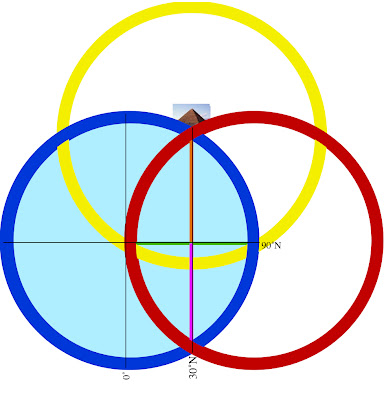 Orient the planet so the Great Pyramid at Giza (30˚N) lays at one of the vertices, the Earth’s center at another, and its axis’ North pole at the third. Exploring this set of relations, it can be demonstrated that the architectural proportions of the Great Pyramid at Giza exhibit a means of utilizing the measure of Earth to express the mathematical constant, π. To understand how we must suspend, for a moment, our habit of thinking of number in purely quantitative terms and consider the ways in which some numbers are also inherently bound to specific geometric forms - like with ‘square’ (1² 2² 3² 4² 5²...) or ‘cubed’ (1³ 2³ 3³ 4³ 5³...) numbers we see a sum attached to a particular shape. Other shapes each possess their own sequence of numbers also attached to their change in proportion. These are called ‘figurate numbers’, and tradition has it they were introduced into Greek mathematics by the pre-Socratic philosopher, Pythagoras, in the 6th century BC. A student of the ancient mystery schools, it is likely he acquired this knowledge during his journeys to Chaldea & Egypt; but all that is really required to calculate the number sequences tied to these shapes is a stack of pebbles and time to spare, counting out the variety of polygons & devising ways of stacking them to construct polyhedrons. To the careful interpreter of nature a pattern was discernible amidst this numerical data - One that, properly placed, could be applied to the measure of all things. It is suggested here that the Great Pyramid at Giza, in relation to the 3-Ring structure given above, embodies this application. Let us then imagine the Great Pyramid as keystone to a system of ‘projective numerology’ - an application of mathematics using figurate numbers to model distances and proportions as shapes, and translating them into their related forms as ‘seen’ from different angles & in other dimensions. At the root of any square pyramid’s architecture is its’ seked - an ancient Egyptian ratio of angular measure used to determine the slope of a pyramid’s sides and thus its’ height.  Utilizing the seked of the Great Pyramid, the perimeter of a square pyramidal base equals the circumference of a circle whose radius is equal to that pyramid’s height. Within our 2-dimensional map, as our planet rotates upon its’ axis, the Pyramid appears to move from one end of a vesica piscis to the other, as if turning on a Wheel whose rim is the 30th parallel. Thus, in one quarter turn (11/14 ≈ π/4) the Pyramid appears to move in a perpendicular line to the base of the equilateral Triangle articulated within our 3-ring diagram. 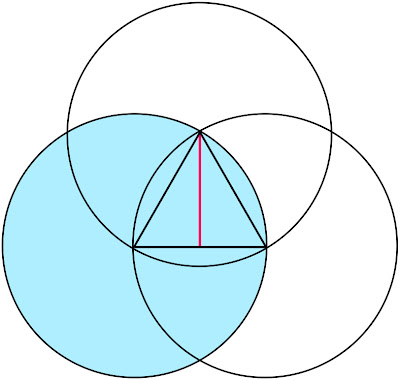  The distance of this perpendicular line from the Great Pyramid to the Earth’s polar axis is 3430 nautical miles, or 10x the cube of seven. Let us then imagine this distance as a stack of 10 cubes, 7x7x7.  A ‘quarter turn’ (11/14) of the Earth thus ‘apportions’ a 10x10 square of these cubes: 10² x 14/11 = 127.27272727...  So, by the logic induced with this arrangement of proportions, distances can be pictured in the mind’s Eye as figurate numbers of octahedral symmetry with 7-unit sides. Reading the Run & Rise of the Great Pyramid’s seked both forward and backward we get a formula for modeling a linear distance of the Earth’s measure as a column made of figurative cubes. 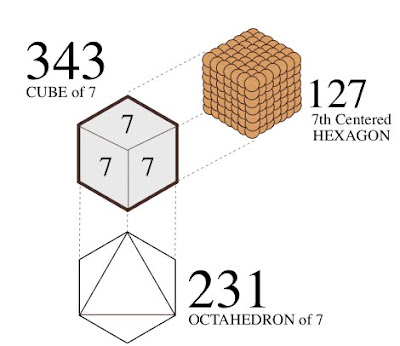 [3d:2d = 343 : 127 ] [3d:2d = 343 : 127 ]As such, we can picture the square pyramid monument atop this ‘column’ as pointing to the center of an imaginary 11th cube. 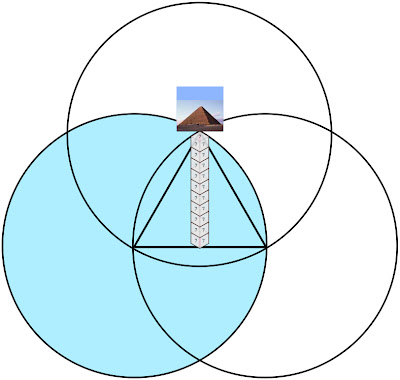 It follows, then, that a 12-hour rotation (180˚) measures a distance from center-point to center-point of the cubes at either end of a column 22 cubes of 7 long. It follows, then, that a 12-hour rotation (180˚) measures a distance from center-point to center-point of the cubes at either end of a column 22 cubes of 7 long.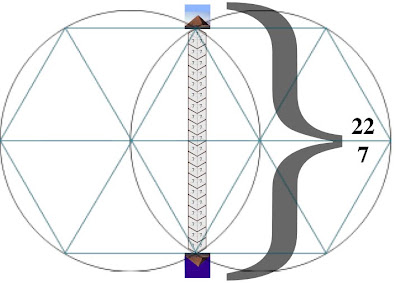 The center point of a unit cube has a specific relationship to the vesica piscis traversed in this 12-hour ‘distance’ within our diagram, as Two rings sharing a single radius give a rational approximation for √3, which is also the space diagonal of any unit cube. 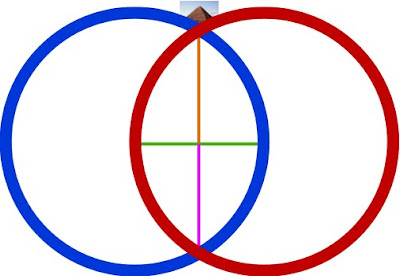  In other words, with respect to a unit cube, the √3 is the distance between opposite corners of that cube. Tracing these space diagonal lines joins the opposing corners, all of which intersect at the center of that cube, and thereby delineate the edges of six square pyramids joined at their apex.  22:7 ≈ π 22:7 ≈ πTo the Egyptian god Thoth, equated with the Greek god, Hermes, and particularly the Roman god, Mercury, this ratio is significant in describing the number of conjunctions aligning Mercury & Earth with the Sun every 7 years. Also known as a ‘synodic cycle’, this is an example of what ancient Greek astronomers called an exeligmos, or ‘Turn of the Wheel’ - describing any period wherein Sun, Moon, and/or planets return to conjunction(s) from which they started. The term is still used today, but is more specifically applied to the Triple Saros cycle of reckoning lunar eclipses, each 120º of longitude apart, eventually returning to a point relatively close to where they began: exeligmos. The Romans used the term annus magnus, or ‘great year’ to describe the same class of periodic event. As we shall see, each of the planets have a harmonic ratio of conjunctions with our planet Earth, and with each other. By fixing the Earth to the center of our ecliptic plane, the motion of other planets relative to our position appear as serpentine spiro-graph patterns, looping in close when aligning into conjunction with the Sun, and looping out to trace a wide arc that coils about the Earth until looping in again for another conjunction. 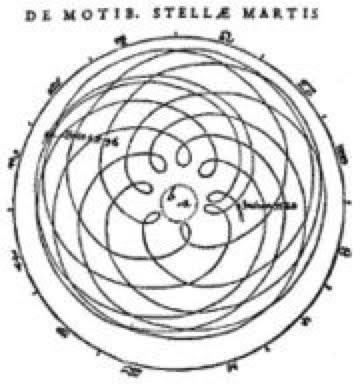 Mars:Earth  Venus: Earth Consistent within our model of 10 cubes of seven, the Great Pyramid (pointing to the center of an eleventh) also corresponds to the tip of an octahedron of 7 = 231. And it just so happens that 11x 231 is the number of days in the exeligmos of Mercury & Earth, 22:7. In addition, the measure of the Great Pyramid’s base side lengths (440 cubits each) give a total base area measuring approximately 231 meters square.Being a close approximation of the value π, and our annus magnus with the planet Mercury (Hermes/Thoth), let us then imagine this column of 22 cubes of 7 as the staff of his Caduceus. As we shall see, the cycles of the other planets can be represented as the serpents entwined about this Staff, their helices in tune with the ratio of their exeligmos.Imparting more than just the inevitable passage of Time, they were the very music of the spheres by which the harmony of creation was made known to the ancient Geometers. Our 3-Rings establish the base unit of an entire system of weights & measures (metrology) by symbolizing an angular dimension constructed by the movement through Time of the Great Pyramid, like the point of a metronome entrained to the Earth’s tempo. In effect attuning the mathematical constant π with Mercury's Great Year & the linear measure of Earth's size in units of angular measure. 'Squaring' the circle much like the Great Pyramid's seked. 1 nautical mile = 1.15 miles The nautical mile used as our base unit of measure for obtaining the distance in cubes of seven is also a unit of angular measure equivalent to 1/60th degree of Earth longitude (=1 minute of arc degree). Converting this into survey land miles = 1/10² the number of days between Earth:Mercury conjunctions (=115). 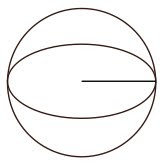 22:7 = 12 hrs @ 30˚north (12x 30 = 360)180˚ = 10,800 arc minutes of degree = 50x 216, the cube of 6216 also equals the number of degrees between Earth:Venus conjunctions (x5 = 1 Earth:Venus pentagram = exeligmos). So, by subdividing each degree of arc into 60 minutes, Earth’s 180˚ rotation (22:7) upon its’ axis thereby possesses a kind of numerological resonance regarding its harmonic with Venus, the exeligmos of the pentagram. Reputedly a symbol of good will among the Pythagoreans, the pentagram also provides an easy means of obtaining the golden ratio. 22:7 = 12 hrs @ 30˚north (12x 30 = 360)180˚ = 10,800 arc minutes of degree = 50x 216, the cube of 6216 also equals the number of degrees between Earth:Venus conjunctions (x5 = 1 Earth:Venus pentagram = exeligmos). So, by subdividing each degree of arc into 60 minutes, Earth’s 180˚ rotation (22:7) upon its’ axis thereby possesses a kind of numerological resonance regarding its harmonic with Venus, the exeligmos of the pentagram. Reputedly a symbol of good will among the Pythagoreans, the pentagram also provides an easy means of obtaining the golden ratio.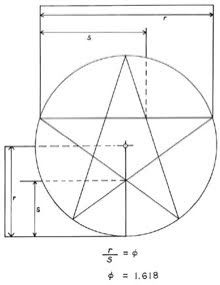 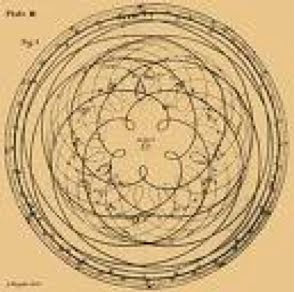 12 : 1 = (22/7) = 60 minutes In this way our measure of both Time & Space define each other by weaving together the value π with the ‘divine proportion’ of the golden ratio. Of the numerous other curious facets to this TooL of Hermetic Metrology, establishing not only our system of weights & measures, its choice of cubes & octahedrons also exhibit a direct connection to speeds of both sound & light: 1 meter =distance trave1ed by sound 1/343th of second =distance trave1ed by light 1/299,792,458th of second 343 = cube of 7 299,792,458 = c = speed of light in meters per second 1296000 / π = number of square degrees in one whole sphere c / 1296000 = 231.321.... 231 = octahedron of 7 Stranger still, the proportions outlined above are also paralleled in the numerical structure of the Tarot de Marseilles’ pattern of 22 major arcana trumps when applied to the Hebrew alphabet - in turn derived from Egyptian (via proto-Sinaitic) hieroglyphs which depicted the symbols those letters are still associated with.  We see traces of this tradition within our own English alphabet with the letter A: also the glyph for an Ox head (turned upside-down) having the same origin as the Hebrew letter aleph. 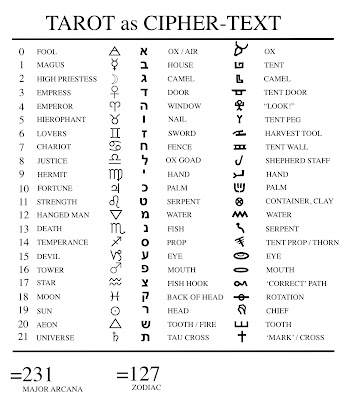 Referred to by 'occultists' as the Book of Thoth (though never adequately explained why), the key to unlocking this puzzle, as with any cryptological TooL, is knowing where to place the cypher, or sifr - the arabic word from which we also get Zero, or ‘nothing’, the rank of every Tarot deck’s Fool [aleph=0]. And this role proves more than suitable for One who ushers in what ultimately reveals a prank, of sorts... leading to what is arguably the greatest punch-line in history.
|
|
|
|
|
|
|
|
| Reply |
Message 17 of 17 on the subject |
|
|
|
|
|
|
|
|
|
LA V CORTA QUE CONTIENE LA LETRA M EN EL CENTRO EQUIVALE A LA V CORTA DE VENUS/VIRGEN/VICTORIA.V=SEXO FEMENINO-A=SEXO MASCULINO. MARIA DE LA VICTORIA ES LA MISMA MARIA LA MAGDALENA.
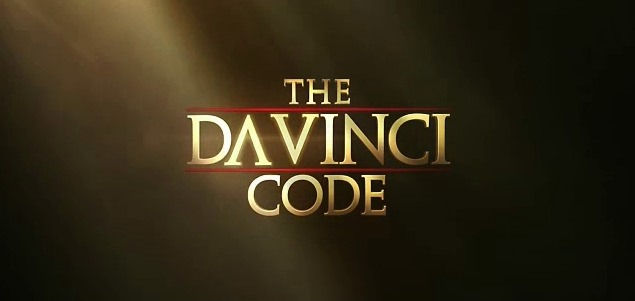
|
|
A gauche, l'emblème maçonnique.
A droite, l'"étoile de David".
Deux barres ou lignes horizontales appliquées sur le compas et l'équerre maçonniques suffisent à faire de l'emblème une étoile de David.
|
|
MATEO 5
37 Pero sea vuestro hablar: Sí, sí; no, no; porque lo que es más de esto, de mal procede.
NOTEN LA CLAVE ESOTERICA CON REFERENCIA AL NUMERO 37
GNOSIS ES UNA REFERENCIA A LA UNION ENTRE EL HOMBRE Y LA MUJER
|
The Heart

HaLev
|
|
|
19 = 5 + 12 + 2 (Ordinal Value) |
 |
| 37 = 5 + 30 + 2 (Standard Value) |
SI=HOMBRE
NO=MUJER
G-NO-SI-S
S-G/ISHTAR GATE
'G', the letter of 'God', the 'Great Architect', the 'Geometer', for G is the 7th letter -
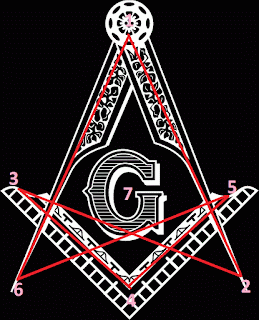 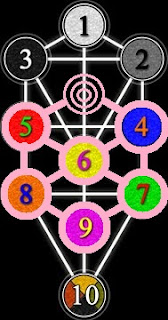
MARY MAGDALENEEAGLE/DAN/M
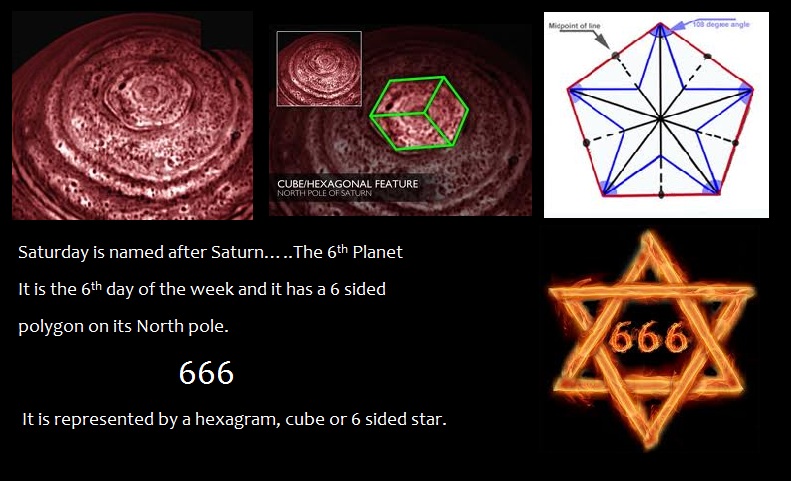
NOTEN LA ESTRELLA DE 6 PUNTAS (NUMERO 33-DOS TRIANGULOS) Y EL AGUILA/PHOENIX EN EL DOLAR
NOTEN LA ESTRELLA DE 5 PUNTAS EN EL CENTRO DEL EXAGONO CENTRO DE LA ESTRELLA DE 6 PUNTAS
EL EXAGONO TAMBIEN ES UNA REFERENCIA AL CUBO
Observen una estrella de 6 puntas=6to dia=sex=six=VENUS/VIERNES (SEXTO DIA DE LA SEMANA)
OBSERVEN QUE TAMBIEN ES UN CUBO
6,7 Y 8
EL LUGAR SANTISIMO DEL TEMPLO DE SALOMON Y DEL TABERNACULO DE MOISES TENIA FORMA DE CUBO Y ESTABA ORIENTADO DE ESTE A OESTE. CONCRETAMENTE DICHO COMPARTIMENTO ESTABA HACIA ADONDE SALE LA LUNA CRECIENTE. ESTO EXPLICA SU FUERTE NEXO CIENTIFICO CON DICHA LUNA, INTERRELACIONADA CON EL NACIMIENTO DE UN NIÑO. LA LUNA CRECIENTE TIENE LA CUALIDAD DE QUE SALE Y SE PONE A LA PUESTA DEL SOL SIEMPRE EN EL OESTE. CONCRETAMENTE EL MENSAJE ESPIRITUAL DEL LUGAR SANTISIMO DEL TABERNACULO DE MOISES Y DEL TEMPLO DE SALOMON TIENE UN FUERTE MARCO, INSISTO CON EL NACIMIENTO DE UN NIÑO, Y MAXIME QUE EN EL CONTEXTO A LOS MESES DEL AÑO EL OESTE NOS CAE EN SEPTIEMBRE U OCTUBRE, OSEA EN LA FIESTA DE LOS TABERNACULOS. TABERNA/VINO/GRIAL.
 EL CUBO DEL LUGAR SANTO DEL TABERNACULO JUDIO, INCLUSO ESTABA DISEÑADO EN FUNCION A LA SERIE DE FIBONACCI, OSEA EL NUMERO DE ORO. EL MENSAJE ESOTERICO ES OBVIO EN EL MARCO A QUE DICHO CUBO ERA EL GRIAL MISMO. EL NUMERO DE ORO ES UNA REFERENCIA A LA ALQUIMIA, OSEA A LA CUADRATURA DEL CIRCULO O CUBICACION DE UNA ESFERA, OSEA A LA UNION ENTRE EL HOMBRE Y LA MUJER. ESE ES EL SIMBOLISMO DE LA ESTRELLA DE 6 PUNTAS QUE ES UNA REFERENCIA AL SEXTO DIA DE LA CREACION O EL ACTUAL SEXTO DIA DE LA SEMANA, EL VIERNES.
 EL HECHO DE QUE HAYA UNA ESTRELLA DE 5 PUNTAS EN EL CENTRO DEL EXAGONO, INSISTO CON FORMA DE CUBO ES UNA REFERENCIA A LA CUBICACION DE UNA ESFERA O EN UN CONTEXTO BIDIMENCIONAL A LA CUADRATURA DEL CIRCULO. ¿QUE LE QUIERO DECIR CON ESTO? QUE LA ESTRELLA DE 6 PUNTAS, SON UNA REFERENCIA A LAS ANTIGUAS 12 TRIBUS DE ISRAEL QUE ESTABAN UBICADAS ALREDEDOR DEL TABERNACULO Y QUE EL CENTRO ES EL LUGAR SANTISIMO MISMO. LA GRAN PIRAMIDE DE GIZE ESTA DISEÑADA CON ESTE PATRON. EL NEXO VENUS/SIRIO CON LA ESTRELLA DE 5 PUNTAS APARENTEMENTE SON UNA REFERENCIA AL PATRON 1989, CUANDO FUE FUNDADA LA PIRAMIDE DE LOUVRE, POR FRANSUA MITERRAND, EN EL CUAL LA LUNA CRECIENTE CAYO EL 7 DE ABRIL (PATRON 47 O 74=SIRIO=GOD =DOG=INDEPENDENCIA DE EEUU)
The Freemasonic symbology of the architecture in Washington, D.C. is replete with occult concepts and references.
The Square and Compass is aligned horizontally to revere the direction in which the Sun as well as the 'Sun behind the Sun' - the Star of Set, or Sirius which is also included in the layout as the White House is not only at the left side of the Compass, but it is at the bottom of the averse pentagram aligned with the North.
The Star Sirius is a binary star, and the lesser star - Sirius B - is depicted as the smaller star to the bottom left; 'The Pentagon'. Even the hieroglyph of Sirius contains the predominant elements of the architecture;
 the Obelisk (Washington Monument), the 5 pointed star, and the Dome (The Capital Building).
SIRIO, APARENTEMENTE ES EL SANTO GRIAL, OSEA UN NUEVO PABLO (PEQUEÑO) QUE ERA DE LA TRIBU DE BENJAMIN/PERRO/LOBO/CHACAL. Recordemos que en el nacimiento de BENJAMIN, el hijo mas chico de JACOB, muere RAQUEL, la esposa amada DE JACOB/ISRAEL. JUSTAMENTE ISIS-RA-ELOHIM NOS DA LA CLAVE EGIPCIA EN EL CONTEXTO HEBREO COMO CENTRO EN LA ALQUIMIA, insisto, la union entre el hombre y la mujer codificada en el mismo centro de la estrella de 6 puntas. JUSTAMENTE ES EN ESTE CONTEXTO QUE EL SEÑOR INTERRELACIONA JUAN 21:11 CON LA INDEPENDENCIA DE ESTADOS UNIDOS. TODO ES UNA REFERENCIA A BENJAMIN EN EL CONTEXTO A LA SEÑAL DE JONAS. EL DISCIPULO AMADO, QUE ES JUAN MARCOS, ES UN NUEVO JONATHAN, OSEA EL HIJO/PRINCIPE HIJO DEL REY SAUL, QUE FUE EL PRIMER REY JUDIO. EL NEXO JUAN MARCOS/BENJAMIN TIENE ESTA CLAVE TIPOLOGICA. RECUERDEN QUE DAVID AMABA A JONATHAN, OSEA EN EL MARCO A QUE NUESTRO SEÑOR FUE HIJO DE DAVID, ES OBVIO QUE EL DISCIPULO AMADO ES UN NUEVO JONATHAN, BENJAMINITA ESPIRITUAL O NUEVO PRINCIPE. ALLI ESTA LA CLAVE ORION/MERCURIO (UNICA SUSTANCIA CONVERTIDA EN ORO) EN EL MARCO A LA SEÑAL DE JONAS. INSISTO, JUAN MARCOS ES UN NUEVO JONATHAN.
|
|
|
|
|
| Reply |
Message 108 of 110 on the subject |
|
|
|
|
| Reply |
Message 109 of 110 on the subject |
|
|
|
|
| Reply |
Message 110 of 110 on the subject |
|
|
|
|
|
|
|
|

Figure 134 is taken from plate xxiv., fig. 1, of Moor’s Hindu Pantheon.
It represents a subject often depicted by the Hindoos and the Greeks, viz., androgynism, the union of the male and female creators. The technical word is Arddha-Nari. The male on the right side bears the emblems of Siva or Mahadeva, the female on the left those of Parvati or Sacti. The bull and lioness are emblematic of the masculine and feminine powers. The mark on the temple indicates the union of the two; an aureole is seen around the head, as in modern pictures of saints. In this drawing the Ganges rises from the male, the idea being that the stream from Mahadeva is as copious and fertilising as that mighty river. The metaphor here depicted is common in the East, and is precisely the same as that quoted in Num. xxiv. 7, and also from some lost Hebrew book in John vii. 38. It will be noticed, that the Hindoos express androgyneity quite as conspicuously, but generally much less indelicately, than the Grecian artists.

In these gifts (which include a jackal’s and goat’s head vessels)
from Late Crete to the Egyptian court
pictured in the tomb of Rekhmire (in Evans Palace 2: 535)
Bull, Lion/ess and Griffin stand out together.
UPDATE August 11, 2014
I found the scholar who can help us continue to put together all that I have collected re: coincidence as evidence thus far.
This site is fantastic from my POV.
How did I find it?
I had a Thoth thought and did a search of the terms ‘orion’s belt double labrys’ and this was the number one return given.
Hence, perhaps, Snake (Winter), Bull (Spring), Lion/ess (Summer)—and Griffin in some supernatural, transcendent relation at a fourth cosmological point. In these gifts below (which include a jackal’s and goat’s head vessels) from Late Crete to the Egyptian court, pictured in the tomb of Rekhmire (in Evans Palace 2: 535), Bull, Lion/ess and Griffin stand out together, as they will in a much later form (Chapter 9).
Book (other chapters) ~ Ancient Lights
The ess highlighted by this author is a bonus meant for me.
In fact I plan to engage the author on his website forum found here Discussion Forums
I have joined the Ancient Lights forum and my name on that forum is of course ‘Raphael’.
Griffin has a Minoan double, the “Genius” or Demon (or, Spirit Being)—at once fantastic and fearsome, protective, predatory, deathless, heraldic, and linked to the sky and stars.

As Ernest and Relke show (2002: 66, 71, Fig. 7), Taweret and an almost-identical deity, “Hippo” were astral deities, “fierce and protective, with a composite of feared and affectionate associations.” They were closely related to Ursa Major, which (in Egypt likened to a bull’s foreleg) never set below the Minoans’ north horizon—and to Draco, the great composite snake, dragon, falcon and/or griffin, winding round the Pole Star. According to one early (though later) writer on astronomy, Eudoxus of Cnidus (a Minoan-affiliated Carian city), sailors called Ursa Minor stars “The Dragon’s Wing”: synecdoche for a stellar guide over the sea, which itself was equated with the cosmic void.
Wow – I AM in awe of what the author Dr. Jack Dempsey has put together.
Finally I have found somebody who I can discuss the deeper meanings of my recovery with, somebody who knows more than me about the symbolism behind the Man, the Eagle, the Lion, and the Bull.
 
Throne of St. Mark
right side of throne – the bull or ox
left side of throne – the man or angel
 
Throne of St. Mark
left front – tamarisk tree with 35 fruit
right rear top – the eagle
right rear botton – the lion

The Gebel el-Arak Knife circa 3450 BC
the iconography on the reverse of the handle is two confronted lions,
flanking a central figure
(note confronted dogs and other animals below)

Cylinder seal of Uruk displaying a confronted-lioness motif
sometimes described as a “serpopard“ – 3000 BC – Louvre
Eagles also have lion heads.
Compare to the Narmer Palette.

Narmer Palette with confronted lionesses, displayed in iconographic registers – Ancient Egypt c. 3,000 BC


disclaimer:
The narrative that has been handed down through the ages is best understood using the filter called:
|
|
|
 Primeira Primeira
 Anterior
199 a 213 de 273
Seguinte Anterior
199 a 213 de 273
Seguinte Última
Última
|
|
| |
|
|
©2025 - Gabitos - Todos os direitos reservados | |
|
|





 [3d:2d = 343 : 127 ]
[3d:2d = 343 : 127 ]

































